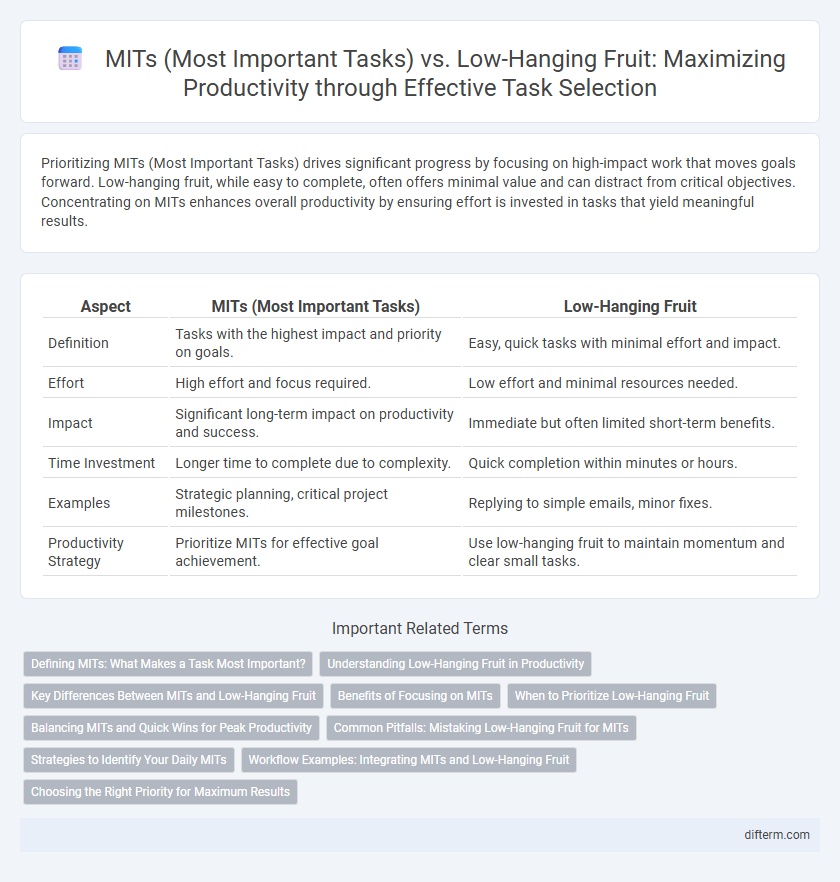Prioritizing MITs (Most Important Tasks) drives significant progress by focusing on high-impact work that moves goals forward. Low-hanging fruit, while easy to complete, often offers minimal value and can distract from critical objectives. Concentrating on MITs enhances overall productivity by ensuring effort is invested in tasks that yield meaningful results.
Table of Comparison
| Aspect | MITs (Most Important Tasks) | Low-Hanging Fruit |
|---|---|---|
| Definition | Tasks with the highest impact and priority on goals. | Easy, quick tasks with minimal effort and impact. |
| Effort | High effort and focus required. | Low effort and minimal resources needed. |
| Impact | Significant long-term impact on productivity and success. | Immediate but often limited short-term benefits. |
| Time Investment | Longer time to complete due to complexity. | Quick completion within minutes or hours. |
| Examples | Strategic planning, critical project milestones. | Replying to simple emails, minor fixes. |
| Productivity Strategy | Prioritize MITs for effective goal achievement. | Use low-hanging fruit to maintain momentum and clear small tasks. |
Defining MITs: What Makes a Task Most Important?
Most Important Tasks (MITs) are defined by their high impact on long-term goals, aligning closely with core objectives and delivering significant value upon completion. Unlike low-hanging fruit, which involves easy wins with minimal effort, MITs often demand focused energy and strategic prioritization to drive meaningful progress. Identifying MITs requires evaluating tasks based on urgency, relevance, and potential to advance critical projects or personal development.
Understanding Low-Hanging Fruit in Productivity
Low-hanging fruit in productivity refers to easy, quick tasks that offer immediate results and minimal effort, often boosting motivation and momentum early in the day. Unlike Most Important Tasks (MITs), which demand significant focus and drive major progress, low-hanging fruit tasks help clear small distractions and create a sense of accomplishment. Prioritizing low-hanging fruit can optimize workflow by reducing task backlog and preparing the mind for more complex, high-impact MITs.
Key Differences Between MITs and Low-Hanging Fruit
MITs (Most Important Tasks) directly impact long-term goals and require significant effort or strategic thinking, whereas low-hanging fruit are simpler, quick wins that provide immediate but often limited benefits. Prioritizing MITs drives substantial progress and meaningful results, while focusing solely on low-hanging fruit can lead to short-term productivity without addressing critical objectives. Understanding this distinction ensures effective time management by balancing urgent tasks with impactful work.
Benefits of Focusing on MITs
Focusing on Most Important Tasks (MITs) drives significant productivity gains by ensuring energy and time are invested in high-impact activities that align with strategic goals. Prioritizing MITs reduces distractions from low-hanging fruit, which often offer minimal value and can fragment attention. This targeted focus enhances decision-making, accelerates progress on critical objectives, and maximizes overall efficiency.
When to Prioritize Low-Hanging Fruit
Prioritizing low-hanging fruit is effective when facing tight deadlines or early project stages to build momentum and gain quick wins. These smaller, manageable tasks boost motivation and clear minor obstacles, enabling smoother progress towards MITs. Balancing MITs with low-hanging fruit prevents burnout and maintains consistent productivity.
Balancing MITs and Quick Wins for Peak Productivity
Balancing Most Important Tasks (MITs) with quick wins enhances peak productivity by addressing both long-term goals and immediate achievements. Prioritizing MITs ensures progress on high-impact projects while completing low-hanging fruit boosts motivation through visible accomplishments. Strategic time allocation between these task types maximizes efficiency and sustains workflow momentum.
Common Pitfalls: Mistaking Low-Hanging Fruit for MITs
Mistaking low-hanging fruit for MITs (Most Important Tasks) often leads to prioritizing easy wins over high-impact activities, reducing overall productivity. Low-hanging fruit delivers immediate satisfaction but fails to address strategic goals crucial for long-term success. Recognizing the distinction between urgent, simple tasks and critical, high-value MITs is key to effective time management and sustained progress.
Strategies to Identify Your Daily MITs
Prioritizing daily Most Important Tasks (MITs) requires evaluating which activities yield the highest impact on long-term goals rather than opting for low-hanging fruit that offers quick but minimal gains. Effective strategies include using time-blocking to allocate dedicated periods for MITs, leveraging Eisenhower's Matrix to distinguish urgent from important tasks, and routinely reviewing objectives to ensure alignment with core priorities. Consistent identification and execution of MITs enhance productivity by focusing effort on meaningful outcomes instead of dispersed, less impactful activities.
Workflow Examples: Integrating MITs and Low-Hanging Fruit
Integrating Most Important Tasks (MITs) with low-hanging fruit enhances workflow efficiency by balancing high-impact priorities with quick wins that maintain momentum. Scheduling MITs during peak productivity periods ensures deep focus on critical objectives, while interspersing low-hanging fruit tasks provides psychological boosts and reduces task backlog. Tools like time-blocking and task batching optimize the seamless transition between complex MITs and simpler tasks, maximizing overall output and minimizing decision fatigue.
Choosing the Right Priority for Maximum Results
Focusing on MITs (Most Important Tasks) drives significant progress by targeting high-impact activities that align with long-term goals, whereas low-hanging fruit often yields quick but minimal gains. Prioritizing MITs cultivates sustained productivity and prevents distraction by less critical, easier tasks. Balancing the two can optimize workflow, but emphasizing MITs ensures maximum results and effective time management.
MITs (Most Important Tasks) vs Low-hanging fruit Infographic

 difterm.com
difterm.com